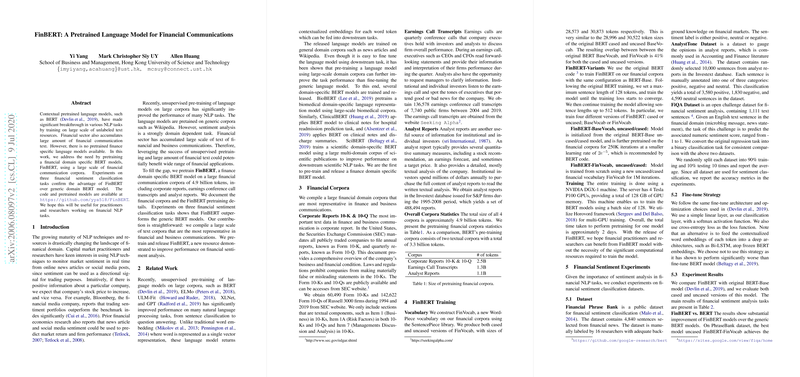FinBERT: A Pretrained LLM for Financial Communications
The paper "FinBERT: A Pretrained LLM for Financial Communications" presents a domain-specific pretrained LLM tailored for the financial sector. This work addresses the lack of financial-specific models by developing FinBERT, a BERT-based model pretrained on a corpus of 4.9 billion tokens sourced from financial documents such as corporate reports, earnings call transcripts, and analyst reports.
Motivation and Approach
Generic LLMs like BERT have demonstrated competence across various NLP tasks but often fall short in domain-specific applications such as financial sentiment analysis, where precise understanding of financial jargon is critical. By leveraging a large, domain-specific corpus, the authors aim to enhance performance in financial NLP tasks.
FinBERT is built using financial documents that provide a robust linguistic framework for understanding financial communications. The pretraining process follows the original BERT configuration with adaptations specific to the financial domain, including a new Word-Piece vocabulary called FinVocab. This vocabulary development process highlights FinBERT’s commitment to reflecting the linguistic nuances of financial text more accurately.
Experimental Evaluation
The efficacy of FinBERT is demonstrated through experiments on three financial sentiment classification tasks: the Financial Phrase Bank, AnalystTone, and FiQA datasets. In each task, FinBERT variants significantly outperform the original BERT-Base models.
- PhraseBank: The uncased FinBERT-FinVocab model attains an accuracy of 0.872, improving upon the baseline BERT models by 4.4% and 15.4% for uncased and cased variants, respectively.
- FiQA: This task shows an improvement of 15.6% for the best-performing FinBERT variant over its baseline counterpart.
- AnalystTone: Here, FinBERT advances the performance by 4.3% to 5.5% over traditional BERT models.
These numerical results indicate the substantial advantage of pretraining on domain-specific corpora, validating the hypothesis that specialized LLMs enhance accuracy in financial sentiment tasks.
Vocabulary Evaluation
One noteworthy aspect examined is the impact of a domain-specific vocabulary. FinBERT versions incorporating FinVocab outperform those using the original BaseVocab, most notably on the FiQA dataset. This outcome suggests that while an in-domain vocabulary is beneficial, the primary performance gains are attributable largely to the extensive financial pretraining.
Implications and Future Directions
The results provide compelling evidence that domain-specific LLMs, like FinBERT, offer tangible improvements in industry-specific NLP tasks. The availability of such a model not only enhances sentiment analysis tasks but also sets the stage for broader financial applications, including forecasts on stock returns and volatility predictions.
Future developments may revolve around expanding FinBERT’s application scope to more intricate financial NLP tasks or improving model scalability and efficiency. As LLM architectures continue to evolve, incorporating specialized data will remain crucial for achieving superior performance in targeted applications.
Conclusion
The release of FinBERT establishes a valuable resource for researchers and practitioners in the financial domain, offering a refined tool tailored for nuanced understanding and prediction beyond general-purpose models. This work marks a significant advancement in creating specialized resources that directly address the demands of domain-specific language processing tasks. By enabling better sentiment analysis and beyond, FinBERT represents a meaningful contribution to financial technology.
